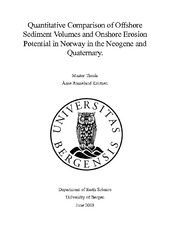| dc.contributor.author | Knutsen, Åsne Rosseland | |
| dc.date.accessioned | 2018-08-15T16:08:35Z | |
| dc.date.available | 2018-08-15T16:08:35Z | |
| dc.date.issued | 2018-06-13 | |
| dc.date.submitted | 2018-06-12T22:01:12Z | |
| dc.identifier.uri | https://hdl.handle.net/1956/18113 | |
| dc.description.abstract | The geodynamic evolution of the Scandinavian topography is the cause of a controversy with several competing hypotheses. Western Scandinavia is characterized by dramatic fjords and high-altitude low-relief surfaces, which is interpreted by mainly two end-member hypotheses. The first hypothesis interpret that the landscape has been eroded down to sea level in Mesozoic, uplifted in Cenozoic and has then been eroded by fluvial and glacial erosion. On the other side of the controversy, is the ICE (isostasy-climate-erosion) hypothesis, which interpret the landscape to be remnants of the Caledonian orogeny, where the topography has been exposed to climate-dependent erosion and isostatic uplift. The motivation for this thesis is therefore to attempt to expand our knowledge and understanding of the hypotheses that are trying to explain the Scandinavian topography. I this thesis, the attempt is to quantitatively compare the Pliocene-Pleistocene offshore sedimentation volume, deposited in the North Sea and along the Norwegian margin, with onshore erosional potential in Norway. This is done by reconstructing the topography, bathymetry and the shelf. Reconstruction of the shelf is based on a new concept, where sediments are re-placed, in a wedge kind of shape, between the Miocene-Pliocene boundary in the west and up to relative sea level at the coast. Estimates of onshore erosional potential consists of fjord and valley erosion, calculated with the geophysical relief method, and inner shelf and coast erosion, which is based on the difference between reconstructed topography and reconstructed shelf. There are several components causing an uncertainty to the results. The reconstructions and volume estimates are tested with varying paleo sea level (PSL) values, porosity and radius for the geophysical relief calculations, which result in a wide range of mismatch volume. When including the assumed realistic values for the uncertainties, there is still some sediment volume offshore that cannot be explained with onshore fjord and valley erosion, and inner shelf and coast erosion. This gives the indication that there must have been erosion coming from somewhere else, e.g. high-altitude low-relief surfaces. Furthermore, due to the high PSLs needed to get an onshore-offshore balance, this indicate that there has been some dynamic uplift along the coast. | en_US |
| dc.language.iso | eng | eng |
| dc.publisher | The University of Bergen | en_US |
| dc.subject | scandinavian topography | eng |
| dc.subject | reconstruction | eng |
| dc.subject | erosion | eng |
| dc.subject | offshore sediment | eng |
| dc.subject | erosjon | nob |
| dc.subject | sedimenter | nob |
| dc.subject | topografi | nob |
| dc.subject | nordsjøen | nob |
| dc.subject | norge | nob |
| dc.subject | norskehavet | nob |
| dc.title | Quantitative Comparison of Offshore Sediment Volumes and Onshore Erosion Potential in Norway in the Neogene and Quaternary. | en_US |
| dc.type | Master thesis | |
| dc.date.updated | 2018-06-12T22:01:12Z | |
| dc.rights.holder | Copyright the Author. All rights reserved | en_US |
| dc.description.degree | Masteroppgave i geovitenskap | en_US |
| dc.description.localcode | MAMN-GEOV | |
| dc.description.localcode | GEOV399 | |
| dc.subject.realfagstermer | https://data.ub.uio.no/realfagstermer/c030753 | |
| dc.subject.realfagstermer | https://data.ub.uio.no/realfagstermer/c003058 | |
| dc.subject.realfagstermer | https://data.ub.uio.no/realfagstermer/c008778 | |
| dc.subject.realfagstermer | https://data.ub.uio.no/realfagstermer/c030209 | |
| dc.subject.realfagstermer | https://data.ub.uio.no/realfagstermer/c000778 | |
| dc.subject.realfagstermer | https://data.ub.uio.no/realfagstermer/c030222 | |
| dc.subject.nus | 756199 | eng |
| fs.subjectcode | GEOV399 | |
| fs.unitcode | 12-50-0 | |
